Most landlords rely on their gut when walking a property during their annual inspection. However, relying on just a mental checklist is a mistake.
A standardized template will help to ensure annual property inspections run smoother, faster, and are more accurate. It also ensures you check everything without relying on memory.
In this article, you’ll learn the steps for inspecting your property to keep it in good condition. Read on to learn how to craft the perfect annual inspection checklist, and download a free sample template you can customize and start using today.
Pre-Inspection Steps
Before creating your landlord inspection checklist, there are a few preliminary steps to take that will make the process easier for yourself and your tenant.
Review Your Lease Agreement
Landlords need to review their lease agreements before scheduling and conducting an annual inspection. It will help ensure the tenant knows their rights, responsibilities, and expectations regarding maintenance and repairs. The review will also help ensure both parties abide by any clauses outlined in the contract.
Complete this review before conducting any inspection as it may reveal potential issues or violations of the lease that you’ll want to address during the inspection. Also, reviewing the lease can clarify who is responsible for certain aspects of upkeep, such as lawn care, replacing air conditioning filters, or exterior security lighting.
It's also a good idea to bring along a copy of your lease agreement to the inspection to quickly access any relevant details. If there are any discrepancies between what's written in the lease and what you're observing during the inspection, you'll have all the lease terms handy.
Notify the Tenant
Next, you should let your tenant know you plan to conduct a landlord inspection. Generally speaking, landlords must give at least 48 hours' notice before conducting the inspection. This notice should be communicated in writing so there is a record of when you informed the tenant.
The notice should also include information such as the date and time of the inspection, what you will inspect, who will be present, and any other relevant details. Additionally, confirm with your tenant that they are available at the specified time for the inspection.
Make sure your tenant understands why you’re performing an inspection, such as ensuring compliance with health and safety regulations or confirming the repair of any existing damage. Remind them of any rules they need to abide by while living in your rental property and validate that they understand their responsibilities.
Schedule the Inspection
Finally, choose a day and time for the inspection. Provide adequate notice to your tenant so they can prepare for it. You should also schedule the inspection far enough ahead of time so tenants can clean up and make necessary repairs before it takes place.
At the same time, try to accommodate your tenant's availability and any other upcoming events that may interfere with the inspection. Being flexible ensures you and your tenant are comfortable with the timing and makes it easier for everyone involved.
In addition, you may wish to have a witness present during the inspection to afford an impartial record of what occurs. Doing this will help avoid misunderstandings or disputes and help to protect both parties from potential legal issues.
Get a Free Landlord Annual Inspection Checklist
With a detailed landlord annual inspection checklist, you can identify any potential problems before they become serious. This process will help keep tenants safe, reduce your liability as a landlord, and save you money in the long run by avoiding costly repairs or renovations that go unaddressed.
Our free template helps you to do just that and is fully customizable with just a few clicks. Download it now and use it to get started on your next annual inspection.

After clicking the link, select "File" at the top left-hand corner of the page, select "Download," then choose the preferred format for your document download.
Creating Your 5-Point Checklist
A landlord's annual inspection checklist should cover 5 main areas: exterior, interior, appliances and utilities, miscellaneous items unique to your rental property, and documentation. Let’s look at each one separately.
1. Exterior
Check the property's structural integrity and note any cracks, leakages, or other damage.
Inspections should include checking the exterior walls, windows, doors, basement and attic, and roof for any damage or signs of wear and tear. Ensure all doors, windows, and locks are in good working order and are keeping the property secure.
- Check gutters, downspouts, and drainage systems.
- Inspect window frames and doors for cracks or water damage.
- Look for any signs of mold, mildew, or rot on the walls or roof.
- Make sure all exterior lighting fixtures are working.
- Ensure there is no visible pest infestation.
- Check for any visible trip hazards, such as loose pavement in walkways.
- Assess the condition of outdoor decks, patios, and fences.
- Verify that garbage cans are sealed and stored away from the building.
- Confirm all electrical outlets and cables outside the property are in good condition.
- Examine the condition of gates and other security features.
- Check that any external stairs are in good working order with no loose boards or missing handrails.
- Make sure there isn’t standing water near the building or rotting debris scattered around the grounds.
- Inspect A/C units to ensure they are securely fastened to their mountings and sealed against moisture intrusion.
- Check for any hazardous trees or branches that need pruning.
2. Interior
Inspections should include a thorough review of each room, noting any areas that need repair or cleaning.
- Walls: Check for any stains, rips, peeling paint, cracks in the drywall, or other structural damage.
- Ceilings: Inspect for water stains that could indicate a roof leak. Check for signs of pests, such as droppings, nesting material, or holes in the plaster.
- Floors: Look for signs of wear, such as scratches and discoloration from spills or pet accidents. Check that the flooring is secure and there are no loose boards or carpeting.
- Furniture (provided by landlord): Test cushions and frames to ensure they aren't broken or damaged. Look for signs of pests like fleas, termites, and bed bugs.
- Carpets and rugs: Inspect the edges for any tears or fraying.
- Windows and doors: Check that locks and latches are working. Make sure windows open and close without difficulty.
- Electrical outlets and switches: Look for any sparks or hot spots on the outlet covers that could indicate faulty wiring. Test all the switches and make sure they turn off and on easily.
- Smoke alarms and carbon monoxide detectors: Test each detector by pressing the “test” button and listening for a loud beep (or red light). Replace any batteries if needed.
- Ventilation systems: Confirm air vents and dryer ducts are free of lint, dust, and debris. Check for any air leaks or blockages that could reduce airflow.
- Plumbing systems: Run the water to check for clogs, low water pressure, and leaks. Inspect drain traps in sinks and bathtubs to ensure they are debris-free.
- Gas lines: If the property has gas service, inspect the pipes and valves and make sure they are in good condition with no leaks or corrosion. Test safety valves as well.
3. Appliances and Utilities
Inspections should include checking all appliances supplied by the landlord to verify they function as designed and meet current safety standards. Be sure to take a close look at items such as:
- Refrigerator and freezer temperature settings
- Stovetop and oven operation
- Water heater safety and functionality
- Backflow preventer
- Master shutoff valves
- Electric panel and circuit breakers
- Septic system (for homes not connected to a public sewer)
Check that all applicable utility services are functioning (e.g., electricity, gas, water) and there is no damage to the landlord’s property due to tenant negligence or misuse of utilities.
4. Miscellaneous
The miscellaneous items on an annual inspection checklist vary from one rental property to another. It may include checking for any signs of pest infestation, testing sprinklers or irrigation systems, confirming stairs and railings meet safety requirements, and ensuring any outdoor structures, such as sheds or decks, are in good condition.
In addition, landlords should consider more specific items related to their particular property. For example, they might check for potential flooding risks if the property is near water.
If the property has a pool or hot tub, ensure it’s in good working condition. If there are any special amenities, like a security system, the landlord should check that it’s up to date and functioning properly. Other items and areas that may need inspection include:
- Testing sump pumps
- Inspecting septic tanks and waste systems
- Turning off the main water line
- Winterizing landscaping
- Cleaning debris out of gutters, drains, and downspouts
- Ensuring security systems work
- Pool, hot tub, and spa inspections
- Examining stairs, railings, and walkways
- Inspecting decks, patios, and balconies for structural stability issues or rotting wood
- Making sure window treatments, like blinds and curtains, are in good working order
- Checking fixtures such as ceiling fans, storm shutters, or built-in shelving
- Removing hazardous materials from the property (e.g., paint cans, propane cylinders)
- Inspecting sprinkler systems to ensure they are functioning and not wasting water
5. Documentation
Finally, document all your findings by taking pictures, writing a report, and making necessary repairs or improvements as soon as possible. Doing this helps to ensure that a landlord’s property remains safe for tenants and stays in good condition for years to come.
Also, keep track of the dates of any inspections, repairs, and improvements made. This way, landlords can easily reference when work was last done and have an easier time staying on top of regular maintenance.
.jpeg)
After the Inspection
After completing your landlord annual inspection checklist, review it with your tenants and discuss anything that needs to be done before the next inspection. Provide tenants with a written copy as soon as possible so they can make any necessary repairs or adjustments.
Wrapping Up
By following these steps, landlords can create an effective annual inspection checklist and make each landlord-tenant relationship a positive and transparent one. This detailed checklist helps to protect the landlord and tenant by validating the property is in good condition and maintained according to landlord standards.
Landlords should also verify their rental property insurance coverage is up to date. Working with an online insurance broker like Obie can make it easier to buy landlord insurance in all 50 states.
Obie’s marketplace offers competitive quotes and straightforward explanations of coverage, so landlords can quickly find the best protection at an affordable cost. Get a free quote instantly by visiting the Obie website and entering your property address.







